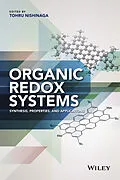- Covers bond formation and cleavage, supramolecular systems, molecular design, and synthesis and properties
- Addresses preparative methods, unique structural features, physical properties, and material applications of redox active p-conjugated systems
- Offers a useful guide for both academic and industrial chemists involved with organic electronic materials
- Focuses on the transition-metal-free redox systems composed of organic and organo main group compounds
Tohru Nishinaga, PhD, is an Associate Professor of Chemistry at Tokyo Metropolitan University. His current research interest is the design, synthesis and application of pi-electron systems with novel electronic properties. Dr. Nishinaga has published over 80 scientific papers and 10 book chapters.
Autorentext
Tohru Nishinaga, PhD, is an Associate Professor of Chemistry at Tokyo Metropolitan University. His current research interest is the design, synthesis and application of pi-electron systems with novel electronic properties. Dr. Nishinaga has published over 80 scientific papers and 10 book chapters.
Inhalt
LIST OF CONTRIBUTO RS xv
PREFACE xix
1 Introduction: Basic Concepts and a Brief History of Organic Redox Systems 1
Tohru Nishinaga
1.1 Redox Reaction of Organic Molecules, 1
1.2 Redox Potential in Nonaqueous Solvents, 3
1.3 A Brief History of Organic Redox Compounds, 5
References, 10
2 Redox?\Mediated Reversible ?\Bond Formation/Cleavage 13
Takanori Suzuki, Hitomi Tamaoki, Jun?\ichi Nishida, Hiroki Higuchi, Tomohiro Iwai, Yusuke Ishigaki, Keisuke Hanada, Ryo Katoono, Hidetoshi Kawai, Kenshu Fujiwara and Takanori Fukushima
2.1 Dynamic Redox ("Dyrex") Systems, 13
2.1.1 p?\Electron Systems Exhibiting Drastic Structural Changes upon Electron Transfer, 13
2.1.2 Redox Switching of a s?\Bond upon Electron Transfer, 16
2.1.3 Two Types of Dyrex Systems Exhibiting Redox Switching of a s?\Bond, 17
2.2 Advanced Electrochromic Response of "Endo"?\Type Dyrex Systems Exhibiting Redox Switching of a s?\Bond, 19
2.2.1 Tetraaryldihydrophenanthrenes as Prototypes of "Endo"?\Dyrex Systems, 19
2.2.2 Tricolor Electrochromism with Hysteretic Color Change in Non?\C2?\Symmetric "Endo"?\Dyrex Pair, 20
2.2.3 Electrochromism with Chiroptical Output of Chiral "Endo"?\Dyrex Pair, 21
2.2.4 Multi?\Output Response System Based on Electrochromic "Endo"?\Dyrex Pair, 24
2.3 Advanced Electrochromic Response of "Exo"?\Type Dyrex Systems Exhibiting Redox Switching of a s?\Bond, 26
2.3.1 Bis(diarylethenyl)biphenyls as Prototypes of "Exo"?\Dyrex Systems, 26
2.3.2 Electrochromism with Chiroptical Output of Chiral "Exo"?\Dyrex Systems, 26
2.3.3 Electrochromism of "Exo"?\Dyrex Systems in Aqueous Media, 28
2.4 Prospect: Redox Systems With Multiple Dyrex Units, 31
References, 33
3 Redox?\Controlled Intramolecular Motions Triggered by p?\Dimerization and Pimerization Processes 39
Christophe Kahlfuss, Eric Saint?\Aman and Christophe Bucher
3.1 Introduction, 39
3.2 Oligothiophenes, 40
3.3 Phenothiazine, 44
3.4 Naphthalene and Perylene Bisimides, 45
3.5 para?\Phenylenediamine, 47
3.6 Pyridinyl Radicals, 49
3.7 Viologen Derivatives, 50
3.8 Verdazyl, 60
3.9 Phenalenyl, 60
3.10 Porphyrins, 61
3.11 Benzenoid, 62
3.12 Cyclophane, 64
3.13 Tetrathiafulvalene, 68
3.14 Conclusion, 80
Acknowledgments, 80
References, 81
4 Tetrathiafulvalene: a Redox Unit for Functional Materials and a Building Block for Supramolecular Self?\Assembly 89
Masashi Hasegawa and Masahiko Iyoda
4.1 Introduction: Past and Present of TTF Chemistry, 89
4.2 Basic Redox Properties of TTF and Stacked TTF, 90
4.2.1 Monomeric TTFs, 90
4.2.2 Interactions in Stacked TTF Dimer, 92
4.2.3 Interactions in Stacked TTF Oligomers, 97
4.2.4 Head?\to?\Tail TTF Dimer, 98
4.3 TTF as a Faithful Redox Active Unit in Functional Materials, 100
4.3.1 Electrochromic Materials, 100
4.3.2 Optically Active TTFs, 102
4.3.3 Uses as Positive Electrode Materials for Rechargeable Batteries, 108
4.4 Electroconducting Properties of TTF Derivatives Based on Supramolecular Self?\Assembly, 112
4.4.1 Redox?\Active Nanostructure Formation in the Solid State, 113
4.4.2 Conducting Nanostructure Formation, 115
4.4.3 Conducting Nanofibers by Iodine Doping, 116
4.4.4 Conducting Nanofibers Based on Cation Radicals, 120
4.4.5 Conducting Nanowires of Neutral TTF Derivatives, 123
4.5 Summary and Outlook, 124
References, 125
5 Robust Aromatic Cation Radicals as Redox Tunable Oxidants 131
Marat R. Talipov and Rajendra Rathore
5.1 Introduction, 131
5.2 Designing Molecules for the Formation of Stable Cation Radicals (Crs)-A Case Study, 135
5.2.1 Exploring the Cause of Exceptional Stability of The?\Orange+·, 137
5.3 Methods of Preparative Isolation of Aromatic Cation Radicals, 142
5.3.1 Nitrosonium (NO+) Salts, 143
5.3.2 Antimony Pentachloride (SbCl5), 144
5.3.3 Triethyloxonium Hexachloroantimonate (Et3O+ SbCl6 -), 148
5.3.4 Ddq and HBF4?\Ether Complex, 149
5.4 Q uantitative Oxidation of Electron Donors using THE-Orange+·SbCl6 - as One?\Electron Oxidant, 150
5.4.1 Analysis of Two?\Electron Oxidation Processes Using MF/D Plots, 157
5.5 Readily Available Electron Donors for the Redox?\Tunable Aromatic Oxidants, 164
5.5.1 Triptycene Based Electron Donors, 164
5.5.2 Tetrabenzodifurans, 166
5.5.3 Polyaromatic Hydrocarbons, 168
5.5.4 Multi?\Electron Redox Systems, 168
5.6 Conclusion, 171
References, 173
6 Air?\Stable Redox?\Active Neutral Radicals: Topological Symmetry Control of Electronic?\Spin, Multicentered Chemical Bonding, and Organic Battery Application 177
Shinsuke Nishida and Yasushi Morita
6.1 Introduction, 177
6.2 Open?\Shell Graphene Fragment : Design and Synthesis of Air?\Stable Carbon?\Centered Neutral Radicals Based on Fused?\Polycyclic p?\System, 179
6.3 Topological Symmetry Control of Electronic?\Spin Density Distribution by Redox and other External Stimuli, 181
6.3.1 Redox?\Based Spin Diversity of Oxophenalenoxyl Sytems, 181
6.3.2 Spin?\Center Transfer and Solvato?\/Thermochromism of Tetrathiafulvalene?\Substituted 6?\Oxophenalenoxyl Neutral Radical, 183
6.4 Control of Electronic?\Spin Structure and Optical Properties of Multicentered C??C Bonds, 184
6.4.1 Strong Somo-Somo Interaction within p?\Dimeric Structure of Phenalenyl Derivatives, 184
6.4.2 Thermochromism Induced by Thermal Equilibrium of p?\Dimeric Structure and s?\Dimeric Structure, 188
6.4.3 Weak Somo-Somo Interactions by Molecular Modification of Phenalenyl System, 190
6.4.4 Multidimensional Spin-Spin Interaction and p?\Staked Radical Polymer, 193
6.5 Rechargeable Batteries Using Organic Electrode?\Active Materials, 195
6.5.1 Closed?\Shell Organic Molecules as Electrode?\Active Materials, 196
6.5.2 Closed?\Shell Organic Polymers, 214
6.5.3 Stable Organic Neutral Radicals, 218
6.5.4 Stable Organic Neutral Radical Polymers, 220
6.6 Molecular Spin Batteries : Design Criteria and Performance of High Capacity Organic Rechargeable Battery Materials, 223
<…